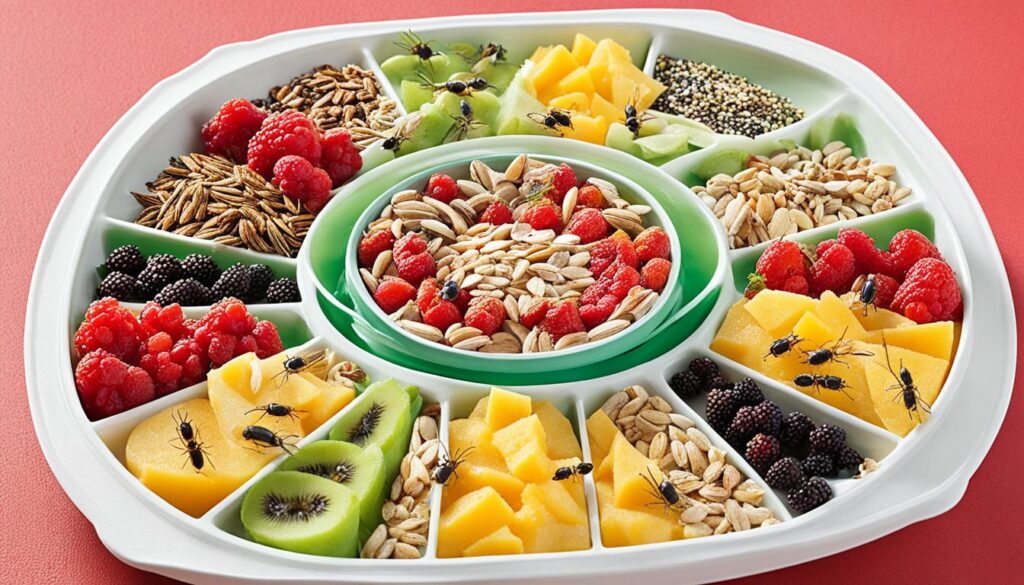I remember the day I found a tiny, featherless nestling near my backyard. It was so small and had a big beak, which made me want to help. I called a local wildlife center and learned that giving them the right food is key for their growth.
Baby birds, whether fledglings or nestlings, need certain foods based on their age and type. They usually eat the same as their parents, like insects, seeds, and worms. But when a baby bird is alone or hurt, knowing what to feed it is crucial for its survival.
Key Takeaways
- Baby birds need a mix of insects, seeds, and natural foods for their growth.
- Feeding them right is key for their health and happiness.
- Fledglings and nestlings have unique food needs and require special care.
- It’s best to get advice from wildlife experts when helping baby birds.
- Getting the food ready right, keeping it at the right temperature, and feeding at the right times is vital for baby birds.
Identifying Whether a Baby Bird Needs Help
Many times, you’ll see young birds with feathers all by themselves. These are called fledglings and are getting ready to fly. They usually have their parents looking after them, even if you can’t see the parents.
Bald or downy baby birds, called nestlings, might need help if they fall from the nest and look hurt or weak.
Signs a Nestling Needs Assistance
If a nestling can’t fly, has wet or tangled feathers, or looks hurt, it might need help. In hot summer months, baby birds can get dehydrated, shown by a wrinkled belly. If you’re not sure about a baby bird’s condition, it’s best to call a local wildlife rehabilitation center for advice.
Recognizing Healthy Fledglings
- Most baby birds found are fledglings, young birds that have just left the nest.
- Fledglings don’t need people to help them, as their parents are still taking care of them, even if you can’t see the parents.
- When fledglings leave the nest, they usually don’t go back. Their parents might be taking care of four or five young ones spread out in different places.
Experts say it’s best not to feed baby birds if you’re not sure they need it. Feeding them can actually hurt them more. Keeping a baby bird in a dark place without food will slow down its metabolism. This gives experts a chance to help.
“If unsure about a baby bird’s condition or what to do, local wildlife rehabilitation centers should be contacted for guidance.”
What can you feed baby birds?
Caring for baby birds means giving them a special diet. This diet helps them grow fast and stay healthy. The right foods for baby birds include a lot of protein. They also need fruits and vegetables as they get older.
High-Protein Foods for Nestlings
Nestling birds need a lot of high-protein food to grow fast. Good choices are finely chopped worms, grasshoppers, mosquito larvae, and other small insects. You can also use fully cooked eggs and protein supplements.
Suitable Fruits and Vegetables
When baby birds get older, they can eat softer fruits and vegetables. Try giving them soft, ripe fruits like blueberries, strawberries, and cherries. These supplemental foods give them important vitamins, minerals, and fiber.
Remember, different baby birds have different dietary needs. Always ask a wildlife rehabilitator or vet for advice on what’s best for your bird.
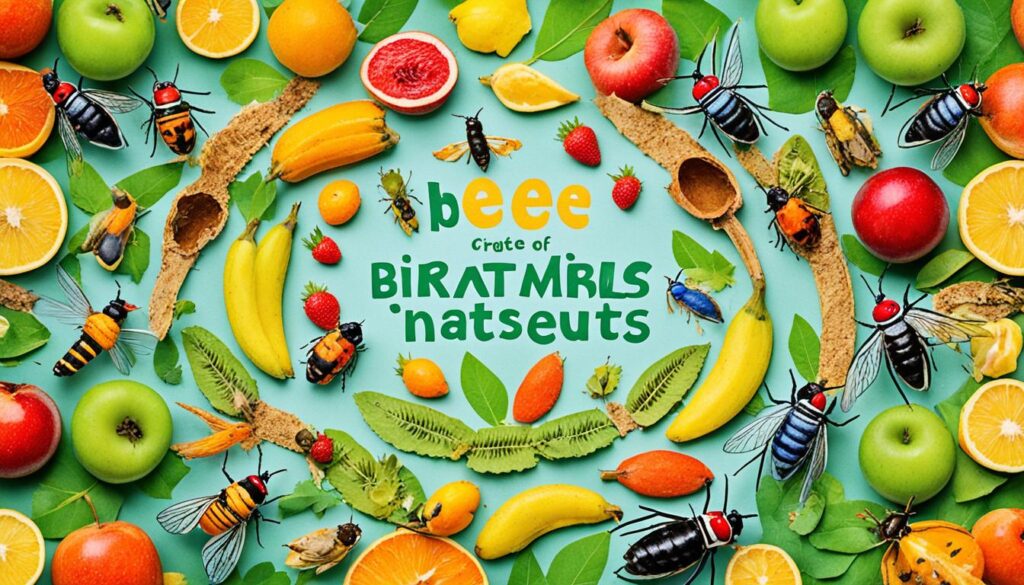
“A baby bird’s diet should consist primarily of insects, which provide the high protein they need for rapid growth.”
Foods to Avoid Feeding Baby Birds
When caring for baby birds, some foods are off-limits. Feeding the wrong items can harm or even kill these young birds. Parents should avoid giving them bread, potato chips, baked goods, honey, milk, raw meat, and spoiled seeds.
These foods often have additives and preservatives not good for baby birds. Instead, give them foods made just for their growth. This includes dry cat or dog food, and nutritious insects like mealworms.
Bread has little nutrition for birds and can cause blockages. Potato chips, nachos, and other junk foods lack the vitamins and minerals birds need.
Some fruits like blueberries, strawberries, and ripe cherries can be given as treats. But raw meat and spoiled seeds are always off-limits. They can carry harmful bacteria that make baby birds sick.
Knowing which human foods are bad helps caregivers feed baby birds right. This ensures they get the nutrition they need to grow strong and healthy.
Preparing and Serving Food for Baby Birds
Feeding baby birds requires careful food preparation and serving. The food should be soft, and its temperature should be at room level. This ensures the young birds’ safety and comfort. Before offering dry foods, make sure to soften them first.
Softening and Portioning Food
It’s important to serve baby birds small, size-proportional portions to avoid choking hazards. Try not to handle the young birds too much to reduce stress and injury risks. Proper portioning and handling are key for their health.
Maintaining Proper Temperature
Keeping the right temperature for baby bird meals is vital. Chicks without feathers need to be kept warm, between 95°F-97°F (35°C-36°C), for good digestion and growth. They also need a humidity level over 50% for their early development.
By preparing and serving food at the correct temperature, you help baby birds get the nutrition they need to grow strong.
“Hand-raised baby birds are reported to grow up with less fear of humans or other dangers.”
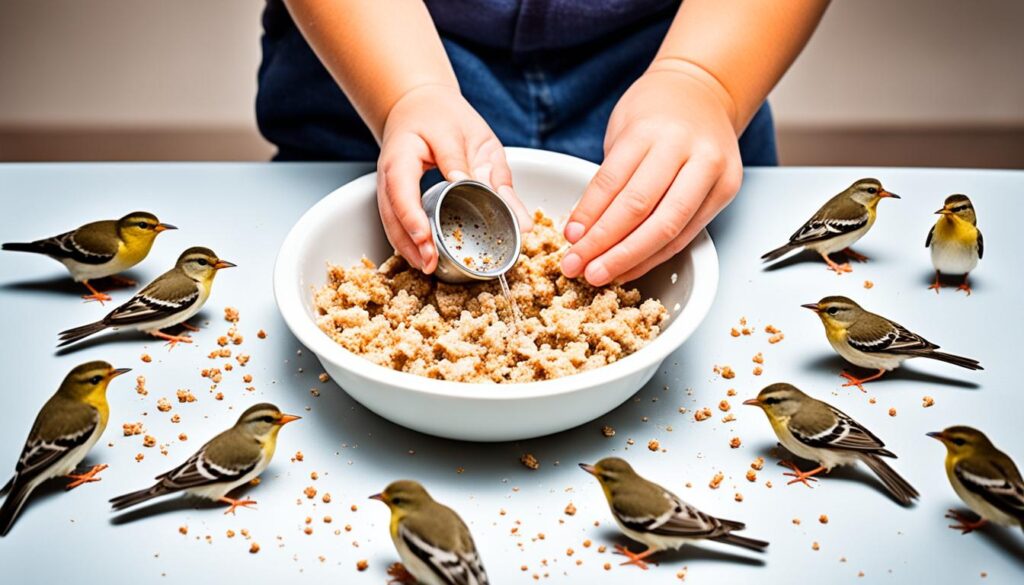
Baby Bird Diet by Species
The dietary needs of baby birds vary a lot by species. For example, seed-eating birds like finches and sparrows need more seeds and grains as they grow. They also need insects when they are young. It’s important to know the specialized diets for young birds to help them grow right.
Seed-Eating Birds
Baby birds that eat seeds have different dietary needs and feeding requirements than young birds that eat insects. As they get older, they need more seeds and grains. This helps their digestive system and gives them energy from carbohydrates and fats.
- Finches, sparrows, and other seed-eaters need to slowly get used to eating seeds and grains.
- Give them a mix of high-protein insects and soft, the right-sized seeds to fit their dietary needs for different baby bird species.
- Slowly add more seeds to their diet as they grow and their digestive system changes to handle the feeding requirements for seed-eating birds.
Knowing the specialized diets for young birds helps caregivers make sure seed-eating baby birds get the right nutrients. This helps them grow and increases their chance of living in the wild.
Hydration for Baby Birds
Along with a balanced diet, clean, fresh water is key for baby birds. Nestlings get moisture from their food, but fledglings might need more water in hot, dry weather.
To help young birds stay hydrated, follow these tips:
- Give them a shallow dish or small container with clean, fresh water.
- Change the water often to keep it clean and stop bacteria or algae from growing.
- Keeping baby bird water sources clean is key to stopping diseases.
Providing water for baby birds and ensuring proper hydration for young birds are vital for their growth. These simple steps will help keep baby birds healthy and strong.
“Staying hydrated is just as important for baby birds as it is for human infants. Providing a clean, fresh water source can make a big difference in their overall well-being.”
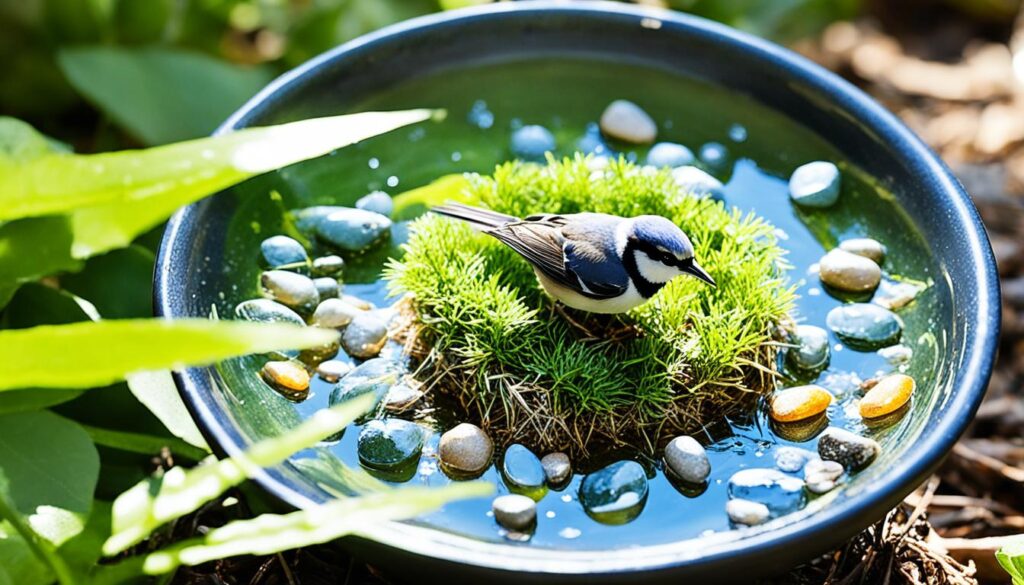
Baby birds can’t manage their own water intake, so watch their hydration levels closely. By focusing on their hydration, you’re giving them a great start in life.
Contacting Wildlife Rehabilitators
If you find a baby bird that looks hurt or alone, the best thing to do is connect with a local wildlife rehabilitation center. These places have experts who know how to help young birds. They can give them the right medical care, food, and shelter.
Trying to care for a baby bird yourself can be harmful. Seeking help from licensed wildlife rehabilitators is key for the bird’s health and its chance of going back into the wild.
- Quick help from a licensed wildlife rehabilitator can save an injured wild bird’s life.
- Only a licensed rehabilitator has the right tools, skills, and knowledge to properly care for wild birds.
- It’s not wise to try to care for a baby bird yourself because it’s hard to release it back into the wild successfully.
Finding local wildlife rehabilitation centers is easy. You can call your state’s conservation agency or look online for ones near you. Many agencies keep lists of licensed rehabilitators. This makes it easy to find the right help for the bird you need to help.
“Fledglings can starve to death if they’re away from their parents and can’t survive on their own. They need to be taken to a rehabilitator if they’re orphaned.”
When seeking professional help for baby birds, be ready to give the rehabilitator details about the bird. Tell them about its condition and where it is. This helps make sure the bird gets the right care and treatment fast.
Temporary Housing for Orphaned Birds
If you find an orphaned baby bird and can’t reach a wildlife rehabber right away, you can give it temporary shelter. This can help it survive. It’s important to make a makeshift nest and keep it at the right temperature and well-ventilated.
Building a Makeshift Nest
To make a temporary nest, use a secure, well-ventilated box or container. Line it with a soft, curved material like a washcloth or paper towels. This helps the bird’s body fit naturally and keeps it safe from injury.
Maintaining Warmth and Ventilation
Keeping the right temperature is key for the baby bird. The ideal temperature is between 85-90 degrees Fahrenheit (30-32 degrees Celsius). Don’t let the bird get too hot or cold, as this can harm it. Make sure the shelter has good airflow to keep the bird comfortable.
This is just a short-term solution. The baby bird should be moved to a professional wildlife rehab center as soon as you can. Quick action can help the bird’s chances of survival until it gets proper care.
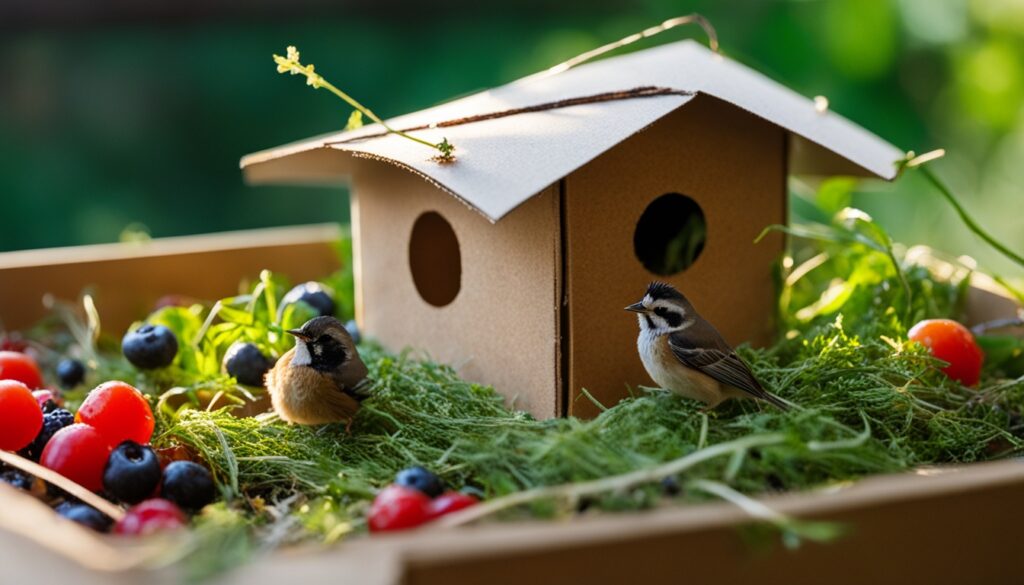
“The best thing you can do for an orphaned baby bird is to get it to a wildlife rehabilitator as soon as possible. They have the specialized knowledge and resources to give the bird the care it needs to survive and thrive.”
Feeding Schedules and Techniques
Feeding schedules and techniques are key for baby birds’ health and survival. These young birds need food every 30 minutes to an hour. It’s important to feed them just the right amount to help them grow well.
When feeding baby birds, use gentle methods like a small syringe or tweezers. Never force the bird’s beak open. This can stress and hurt the bird. Wait for the bird to open its mouth and then gently put in the food.
- Keep a regular feeding schedule to match what parent birds do, which can be many times a day.
- Slowly increase the food amount as the baby bird gets bigger and eats less often.
- Give a quiet, warm, and safe place for feeding to reduce stress and keep the bird comfortable.
By using the right feeding schedules for baby birds and techniques for feeding young birds, you can prevent common mistakes when feeding baby birds. This helps these precious birds survive and grow healthy.
“The feeding process for baby birds involves filling their crop frequently due to their rapid growth rate.”
Monitoring Baby Bird Growth and Development
Watching the growth of a baby bird is key to making sure they’re doing well. Look at their physical look, weight, and how they act. Nestlings should grow steadily, while fledglings should get more active and independent as they learn to fly. If a bird seems to be growing too slowly, looks tired, or shows other worrying signs, get help from a wildlife expert right away.
Here’s how to tell if baby birds are doing well:
- Nestlings, young birds without many feathers, should get heavier and grow feathers as they go.
- Fledglings, birds with feathers that can hop or flutter a bit, should move more, flap their wings, and try to fly as they get ready to be on their own.
But, there could be problems with baby bird growth, like:
- Not getting heavier or growing
- Being very still or less active
- Feathers that look odd or don’t grow right
- Signs of injury or sickness
“Closely monitoring the growth and development of baby birds is essential to ensure their well-being and successful transition to independence.”
By keeping an eye on the growth and development of baby birds, you can spot the signs of healthy progress and potential issues. This helps you give the right care or get expert help when needed.
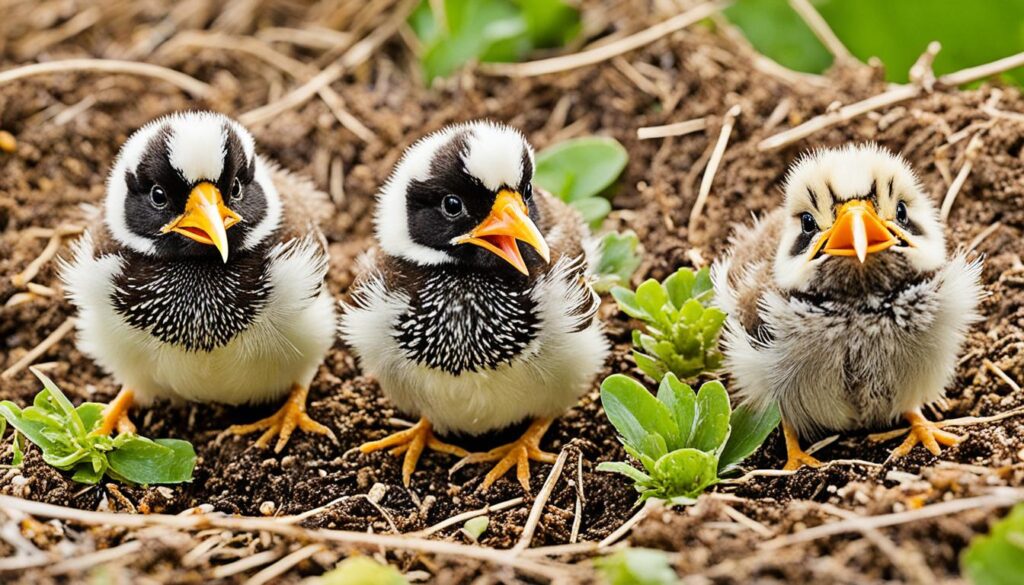
Release and Independence for Fledglings
As baby birds grow into fledglings, we aim to help them return to the wild. This process needs careful planning for a good outcome. We prepare them by introducing them to natural foods and environments. We also teach them survival skills to help them thrive alone.
Helping young birds adapt to the wild is key to their growth. Fledglings face a high mortality rate in just a week or two. They struggle to find food, fly well, and defend against predators. An extra week of parental care can cut the mortality rate in half, showing how crucial a gradual transition is.
Ensuring baby birds make a successful transition is complex. Parental care boosts fledglings’ survival chances but takes time from the parents. Garden birds usually feed their young for about two and a half weeks. After that, the young birds must learn to survive on their own.
“Survival rate for fledglings without parental care drops to 30% – 40%, mainly due to predators.”
It’s vital to leave food out for fledgling birds when their parents stop feeding them. Their diet should mainly include insects. Fruits, vegetables, birdseed, and small nuts can be added as supplements. This support can greatly increase their survival chances during this tough time.
During this transition, it’s important not to handle the baby birds too much, as it can be fatal. Keeping pets inside for 1 – 5 days can also help fledglings survive better in gardens. It lowers the risk of being eaten by predators.
Prevention: Keeping Baby Birds Safe
Keeping baby birds safe is key to protecting them from dangers. By acting early, we can make a safer place for these young birds. This helps reduce the need for them to be treated or rehabilitated.
One way to keep baby birds safe is by keeping pets like cats and dogs inside. This keeps them away from where the birds nest. Also, being careful around things like windows, cars, and outdoor machines can lower the chance of birds getting hurt.
- Avoid disturbing nests or fledglings (young birds just starting to fly) to prevent disrupting their natural development and care.
- Plant shrubs, trees, and tall grasses to give baby birds places to hide and stay safe from predators.
- If you find a fallen nest, put it back in a tree or bush so the parents can keep caring for their babies.
It’s also important to watch how baby birds act and their surroundings. If you see a fledgling on the ground, watch it first. Don’t touch it unless it looks hurt or is in danger. Parents usually come back within 30 minutes to check on their babies.
“If a fledgling is found on the ground, it’s important to observe the situation and not intervene unless the bird appears injured or in immediate danger. Parents typically return within 30 minutes to check on their offspring.”
By taking steps to prevent baby bird injuries, we help protect these young birds. This supports their growth and survival. Making sure they are safe is key for keeping bird populations healthy. It also helps us live in harmony with nature.
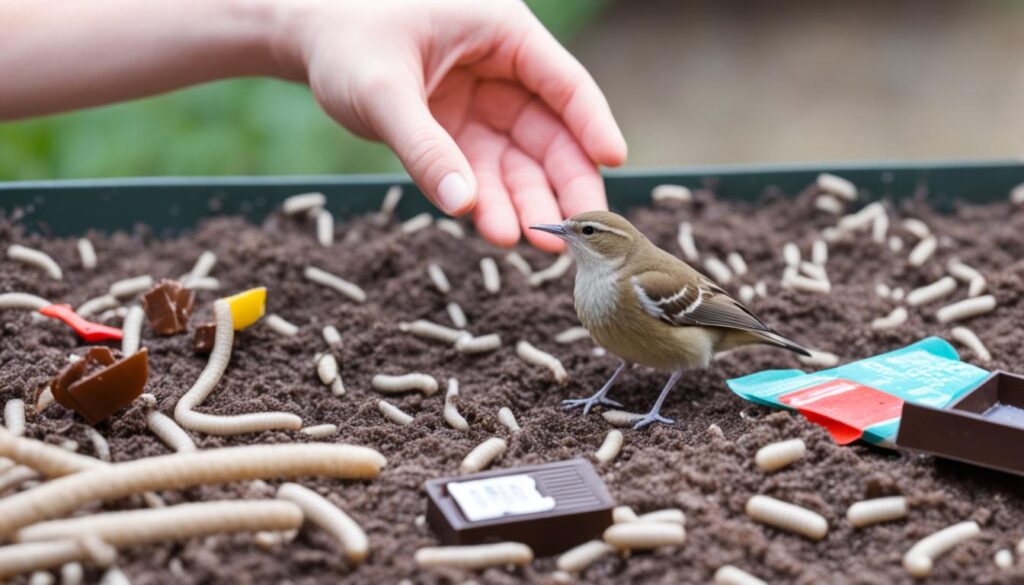
Conclusion
Caring for baby birds is a delicate task. It involves giving them the right food, shelter, and protection. It’s important to know their special needs and get help when needed. We’ve covered the key points on feeding and caring for baby birds. This shows why expert help is key for baby birds that are orphaned or hurt.
We’ve looked at the main parts of caring for baby birds. This includes spotting when they’re in trouble, making the right food, and keeping their home safe. The facts we shared show how important it is to adjust their care based on their age and type of bird. By doing this, we can help baby birds grow strong and become independent.
Looking after baby birds is a big job that goes beyond what one person can do. We must support local wildlife centers and tell experts about any bird issues we see. Together, we can help protect and grow the next generation of birds. This keeps our natural world healthy and diverse.
FAQ
What can you feed baby birds?
Baby birds need specific foods that change with their age and type. They eat the same food as their parents, like insects, seeds, and worms. It’s important to feed them right for their growth and health.
What are the signs a nestling needs assistance?
Look for signs like not flying, wet or matted feathers, or injury. If unsure, call a local wildlife rehab center for advice.
How can you recognize healthy fledglings?
Healthy young birds, called fledglings, are usually cared for by their parents, even if you can’t see them. They are getting stronger before they fly. Leave them alone unless they seem injured or weak.
What are the high-protein foods for nestlings?
Baby birds need lots of protein for growth. Good options include chopped worms, grasshoppers, and mosquito larvae. Cooked eggs and protein supplements can also help.
What fruits and vegetables are suitable for baby birds?
Some baby birds can eat soft fruits like blueberries, strawberries, and cherries.
What foods should you never feed baby birds?
Never give baby birds bread, potato chips, baked goods, honey, milk, raw meat, or spoiled seeds. These can be harmful or even deadly.
How should you prepare and serve food for baby birds?
Serve food that’s soft and at room temperature. Make sure it’s not dripping to prevent choking. Use small amounts that fit the bird’s size to avoid choking.
How do the dietary needs of baby birds vary by species?
Different baby birds have different diets. For example, some eat more seeds and grains as they grow, besides insects.
How can you provide proper hydration for baby birds?
Give baby birds clean, fresh water. Use a shallow dish or small container and change the water often to keep it clean.
When should you contact a wildlife rehabilitator?
Call a wildlife rehab center if you find a baby bird that looks injured or orphaned. They have experts who can help with care, nutrition, and housing.
How can you create temporary housing for an orphaned baby bird?
Use a secure, well-ventilated box or container for temporary housing. Line it with soft material for the bird’s body. Keep the temperature right, avoiding extreme heat or cold.
How often should you feed baby birds?
Baby birds need to be fed often, every 30 minutes to an hour. Be careful not to overfeed or underfeed them. Use a syringe or tweezers to feed gently, without forcing their beak open.
How can you monitor the growth and development of baby birds?
Watch the baby bird’s growth closely to make sure it’s doing well. Look at their appearance, weight, and behavior. If they’re not growing or acting right, call a wildlife rehabber right away.
How can you help fledglings transition back into the wild?
Help fledglings go back to the wild by giving them natural foods and environments. Also, teach them survival skills.
How can you prevent the need for intervention with baby birds?
Keep baby birds safe by protecting them from predators and not disturbing their nests or fledglings. This helps them stay healthy in the wild.
